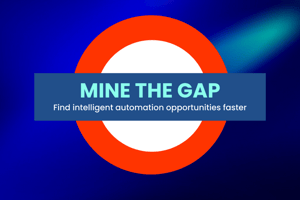robotic process automation process mining process modeling
RPA: Automation with Intelligence
There’s a school of thought that says a tool is only as useful as the vision, skill and ambition of the person using it. There’s some debate whether Henry Ford actually said, “If I had asked people what they wanted, they would have said faster horses”, but it’s easy to see why such a good quote became apocryphal. Sony invested a lot of money and effort in making their portable CD players ever thinner and less likely to skip while playing a track on the move – until Steve Jobs announced the first iPod in 2001. Change can be limited to tweaking the current state or it can be transformative. Only one of these two delivers competitive advantage.
Deloitte’s most recent global survey1 on intelligent automation (IA) is fascinating. An impressive 73% of the organizations polled have active IA projects, up from 58% the previous year. By far the most common technology being implemented was Robotic Process Automation (RPA) with 78% saying they’d already deployed it in some form, and another 16% intending to do so within three years. However, look beyond these attention-grabbing headlines and things get… interesting.
The Devil’s Always in the Detail
Despite the high percentage actively embracing the technology, only 26% of those with pilot projects, and only 38% of those implementing and scaling, have an enterprise-wide IA strategy. What’s more, Deloitte noted a distinct difference between organizations running pilot and those who’d progressed to implementing and scaling – “The latter are more likely to reimagine what they do and incorporate process change across functional boundaries. Those in the piloting stage are more likely to automate current processes, with limited change – they may have not yet taken advantage of the many technologies and techniques that can expand their field of vision and open up even more opportunities.” Just think about that for a moment – ”…more likely to reimagine what they do and incorporate process change across functional boundaries.”
It’s a sobering picture but it’s easy to understand how those strategy-less organizations ended up where they did. Take RPA for example. It’s an invaluable technology but its greatest strengths are also its greatest weaknesses. It’s easy to implement and readily solves easily identifiable manual issues – and as a result, it tends to get used as a point solution to obvious problems. In their haste to make the horse run faster, people miss the opportunity to step back and build an internal combustion engine. The sort of questions they don’t get asked are:
- How have our new solutions changed the flow of the end-to-end process, and is that good or bad?
- Are there remaining bottlenecks (or have we just moved the old ones downstream?)
- Have we created unintended consequences, such as instabilities, backlogs in other steps, or compute pressures on legacy systems, trying to keep up with the robots)?
- What other optimization opportunities exist?
- How have we affected our operational resilience, for good or for ill?
See the Wood, Not Just the Trees
Based on its survey data, Deloitte identifies several barriers to organizations realizing transformational benefits from IA. The most common is fragmented processes which they define as “when business‐critical processes are not managed in a unified workflow. They become a series of handoffs among departments, teams and systems, introducing a risk of error and delay with each handoff.” This was also the most common barrier in the previous two surveys.
One of their suggested solutions is to use process mining and monitoring to highlight inefficiencies within end-to-end processes. Another is the creation of detailed process definitions, together with standards and governance, – only 38% of respondents said their organization had these. Echoing our previous blog on operational excellence, Deloitte advises that “process excellence should be part of every intelligent automation programme” because it “allows you to review business‐critical processes, identify pain points or blockers, and understand their upstream and downstream counterparts. Then processes can be simplified or eliminated before delivering task‐based automation. Or even better, end‐to‐end processes can be reimagined before making use of intelligent automation technologies.” We couldn’t agree more.
At BusinessOptix, we believe in a data-driven approach to intelligent automation and have built our platform with the capabilities you need to create a clear picture of your current state, analyze your end-to-end processes, design, and implement your reimagined future state, monitor the effects of your changes, and optimize on an ongoing basis.
An organization of any significant size is a complex, interconnected system. Our platform helps you to understand the upstream and downstream consequences of point automations and enables you to orchestrate your portfolio of projects more effectively. It allows to do more than create a faster horse by creating status dashboards – and even a digital twin of your real-world organization – which enable you to discover new optimization opportunities and areas of operational risk.
Perhaps the most interesting thing about Deloitte’s survey is that respondents are aware of tools which could help them but aren’t using them. While 80% believe process mining and process monitoring tools enable better outcomes only 20% are using mining and only 33% are using monitoring. Perhaps that’s due to the tactical nature of many IA projects but whatever the reason, it’s a significant missed opportunity and puts those companies at a competitive disadvantage to others who take a more strategic, transformational approach.
Intelligent automation offers huge benefits if you automate intelligently. The tools exist to let you see the big picture, reimagine your organization, and verify the changes you make are giving you the anticipated benefits. You just need to use them.
References:



